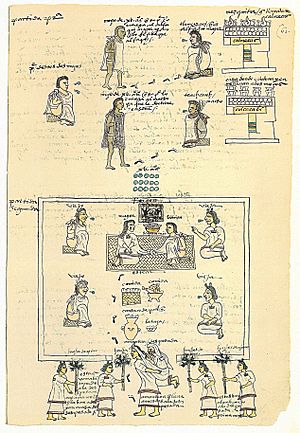Gender roles in Mesoamerica facts for kids
Mesoamerica was a large region in the Americas, stretching from central Mexico down to Honduras and Nicaragua. Many ancient societies, like the Maya and Mexica (Aztec), thrived here before Europeans arrived in the 1500s.
In these societies, gender roles were often seen as "complementary." This means that men and women had different jobs and responsibilities, but both were considered equally important for the community to succeed. Sometimes, a person's role wasn't strictly tied to being a man or a woman. These roles also changed depending on the specific culture, the time period, and a person's social standing.
When the Spanish arrived in the 16th century, they brought their own ideas about gender roles. This changed many of the traditional Mesoamerican practices. However, even with these changes, some parts of the ancient gender roles still exist in indigenous communities today.
Contents
Daily Life and Work
Ancient Mesoamerican art shows us how men and women typically divided their work.
Who Did What Work?
Women were often shown doing jobs like weaving cloth, raising children, caring for animals, and giving birth. Weaving was especially important for women in Mexica culture, while for the Maya, it showed a person's social class. Men were usually shown with weapons or in positions of religious and political power.
While farming was often seen as a man's job, it's likely that everyone helped out. Studies of women's bones show signs of wear from grinding maize (corn). This suggests that women spent a lot of time preparing food. Experts believe that men, women, and children all worked together on farms and in their homes.
Women's Roles in the Family
Women had many important jobs within their families. They harvested grains, prepared food, and took care of farm animals.
- Farming Tasks: Women were often responsible for planting and harvesting crops. However, in some societies, they were not allowed to plough the fields. This was because ploughing was seen as a male task, linked to men's role in creating new life. So, even if a woman was the head of a household, she might need a man's help for certain farming jobs.
- Food Preparation: After harvesting, women spent a lot of time preparing food. One of their main jobs was turning dried corn into maize dough. They would boil the corn with lime, then grind it on a special stone called a metate. This dough was used to make many different foods. Women often spent long hours by the hearth (fireplace) doing this.
- Caring for Animals: Many families had corrals (pens) for their animals. Women were often in charge of these animals. They would spend a lot of time in the corral, feeding chickens, cleaning dovecotes (bird houses), and caring for other animals like mules and rabbits. This work was very important for the family's survival.
The last major role women hold in a society relates to animals. Many households have corrals for their domestic animals, and this is another area that women are responsible for. When discussing the roles women play with domestic animals the corral is very important to the women of the household and is another area where they spend a great deal of their time. Here she spent a good part of her time, taking care of the animals…caring for the chickens, cleaning the dovecote, feeding the mule, rabbits…here in the corral one eats from one’s work.
Women's hard work in producing food and textiles (cloth) was also vital for religious rituals. These rituals helped keep good relationships with the gods and within communities. For example, Diego de Landa observed that Mayan women prepared food and cloth for almost all rituals, both for offerings and for people to eat.
Among the Mexica, gender roles were also complementary. For instance, dying in battle was considered a great honor for men. Similarly, for women, dying during childbirth was seen as equally honorable. If a woman died in childbirth, her body was believed to have special power from the goddess Cihuacoatl. Her husband would watch over her body for four nights to honor her.
Power and Leadership
Some women in Mesoamerican societies held important political roles.
Women in Politics
In Maya society, some women became political leaders. However, women in Mexica society generally could not hold these top political positions. Even so, Mexica women had equal legal and economic rights as men. Noble Mexica women could also become priestesses.
The Mexica government had two very powerful leaders. One was the tlatoani, which means "the one who speaks." This leader was in charge of military matters. The other was the cihuacoatl, meaning "woman snake." This leader handled domestic affairs, like making sure there was enough food and managing justice. Even though the cihuacoatl position was held by a man, it was strongly linked to female power. The cihuacoatl would even wear women's clothing for ceremonies, honoring the goddess of the same name.
Over time, as Mesoamerican states became more organized, men's power often grew stronger, especially their control over women's work and their ability to have children. This sometimes led to fewer opportunities for women. For the Mexica, the focus on military strength might have reduced women's public importance.


